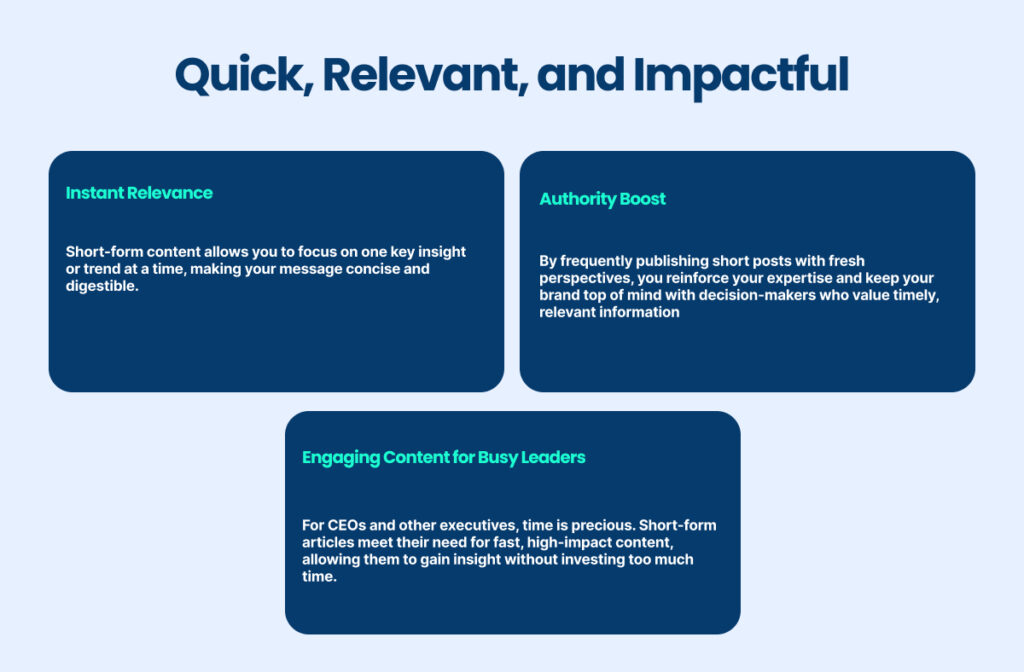Highlights
- Short-form content is ideal for quick engagement, building instant authority, and staying relevant with concise, impactful insights.
- In-depth articles and white papers build credibility by providing well-researched, data-driven insights that resonate with business leaders seeking reliable, detailed information.
- Live formats like webinars and podcasts humanize CEOs, fostering direct audience engagement and enhancing brand authority through real-time, authentic interactions.
True thought leadership is more than sharing knowledge. It’s about challenging norms, inspiring new perspectives, and influencing positive change within an industry or community.
Standing out as a true expert is no easy feat.
But what if you could position yourself as the go-to authority in your field, attracting a loyal following and driving business growth? That’s the power of thought leadership content.

Decision-makers trust thought leadership content more than marketing materials or product sheets.
As a result, a reliable Thought Leadership Agency can help businesses build credibility and authority.
Let’s explore the types of Thought Leadership Content and Choose the Right Format for the Audience.
Quick Impact: How Short-Form Articles and Blog Posts Build Instant Authority
Grabbing attention and establishing authority quickly is essential, especially for business owners and CEOs.
Short-form articles and blog posts directly showcase expertise and share relevant insights, positioning your brand as a go-to source for valuable information.
These quick reads meet decision-makers right where they are — seeking fresh, actionable ideas without the lengthy commitment.
Quick, Relevant, and Impactful: Short-Form Content as a Trust Builder
Unlike lengthy whitepapers or in-depth reports, short-form content delivers value upfront. Think of it as a reliable handshake in the world of digital communication.
Each piece may be just 300-800 words, but if crafted thoughtfully, it can effectively establish immediate trust.

Pro Tip: Use statistics and data points in your short-form content. Studies show that executives are more likely to trust content backed by data. When you combine a powerful insight with a relevant statistic, you strengthen your position as an authority.
Fast & Effective: The Power of Short-Form Content for CEOs
For CEOs, short-form content provides more than just a quick read.
Source: Opinions about short-form online video content, Statista
It is a powerful tool to communicate critical insights, industry shifts, and strategic perspectives to stakeholders and potential clients.
Stay Relevant Without the Overload
In a world overloaded with information, CEOs often want to quickly digest new trends, thought leadership strategies, and thought leadership ideas. Short-form content delivers high-value ideas without overwhelming them.
- Focused Information: Avoids clutter and presents only the most impactful ideas.
- Easy-to-Share: Perfect for LinkedIn, newsletters, or email, short articles allow CEOs to share insights with their networks, building credibility and fostering engagement.
- Elevate Brand Voice: Each post reflects your brand’s voice, values, and strategic brand positioning, reinforcing trust with a consistent flow of insights.
Quick Wins to Demonstrate Value
With short-form articles, CEOs can share immediate wins, whether a new trend, a company milestone, or an actionable industry tip. These posts are quick to produce, publish, and promote.
- Timely Information: Share news as it happens, giving your brand a sense of immediacy and relevance.
- Accessible Knowledge: Position yourself as an accessible thought leader by breaking complex topics into digestible pieces.
- Data-Driven Insights: Pair brief insights with stats for increased credibility. For instance, if discussing digital PR strategies, mention how a recent campaign increased visibility or engagement.
Why Short-Form Content is Essential for Staying Relevant and Visible
In the digital space, visibility is key. Short-form content is ideal for keeping your brand storytelling techniques relevant, especially in fast-evolving industries.
Frequent Publication for Maximum Reach
Posting shorter articles more frequently increases your visibility, making it easier for search engines to find you and for audiences to engage with your brand.
- Enhanced SEO: Short-form posts published frequently improve the role of thought leadership and SEO and help you stay top of mind.
- Audience Touchpoints: Regular posting creates more touchpoints with your audience, boosting brand recognition and familiarity.
- Thought Leadership Best Practices: Establish a posting routine once or twice weekly. This consistency strengthens your authority over time.
Adapting to Real-Time Changes
Short-form content allows you to adapt to changes in your industry without a long production timeline. CEOs and business owners must stay agile, and short-form content provides the flexibility to respond to trending topics or market shifts in real-time.
- Stay Current: Highlight emerging trends or recent events to keep your brand relevant.
- Demonstrate Agility: Show your audience that your brand is on the pulse of industry developments, reinforcing your position as a proactive thought leader.
Beyond the Basics: Why Business Leaders Should Embrace In-Depth Articles
In the digital age, where snippets and sound bites often dominate, in-depth articles remain a powerful tool for CEOs and business leaders.
While short-form content helps with quick engagement, longer articles delve deep, showcasing thought leadership on a more profound level.
The Power of Depth: More Than Just a Trend
In-depth articles allow leaders to go beyond the surface, providing context, clarity, and real value. Unlike shorter posts, these articles explore complex topics, offering thorough insights that highlight your expertise.
Source: That Agency
This depth demonstrates thought leadership for CEOs and executives that resonates with audiences seeking credible, actionable insights.
- Establish Credibility with Thorough Analysis: In-depth articles position you as a trusted voice. They allow you to thoroughly address questions, challenges, and trends, proving you’re not just skimming the surface.
- Build Authority with Data-Driven Insights: Including data, research, and expert insights strengthens your authority, creating a foundation that builds trust and attracts readers.
Consider this: 70% of decision-makers agree that different types of thought leadership content makes them more likely to do business with an organization. By producing comprehensive articles, you meet their expectations, addressing their concerns directly and convincingly.
Why Business Leaders Benefit from Long-Form Content
For business leaders, connecting with an audience that values thorough, well-researched information is crucial.
In-depth articles enable you to speak directly to their needs, showing you’re willing to tackle complex issues and provide thoughtful solutions.
- Address Complex Problems: Short-form content might work well for tips or brief updates, but for real issues, your audience needs more. In-depth articles let you dig into challenges faced by your industry and offer clear, researched solutions.
- Earn Trust by Answering ‘Why’ and ‘How’: Your audience likely has unanswered questions. An in-depth article allows you to explain the why and how providing a comprehensive answer that shorter content simply can’t deliver.
For example, imagine a CEO writing on digital transformation. While a short post might list benefits, a longer piece can explain step-by-step implementation strategies, showcase industry case studies, and address potential pitfalls.
This level of detail builds a reputation for thoroughness, positioning the author as a go-to source for valuable knowledge.
Voices of Experience: Why Every CEO Needs a Signature Interview
CEOs are no longer just company heads; they’re the faces and voices behind their brands.
A signature interview—whether it’s in a podcast, a feature article, or a recorded video conversation—offers a CEO an unparalleled platform to connect authentically with their audience.
Beyond the Boardroom: How Interviews Make Leadership Relatable
Interviews break down the formality often associated with executive roles, allowing leaders to speak candidly about their journey, successes, and challenges. This level of openness attracts interest and makes CEOs more relatable.
For business owners, connecting authentically is key to establishing a loyal audience and building trust within the industry.
- Establishing a Personal Brand: An interview lets CEOs define their identity beyond their job title. Sharing thoughts on industry challenges, emerging trends, or even personal philosophies gives audiences a sense of the person behind the brand, building authenticity.
- Creating Emotional Connections: People connect more deeply with personal stories than data. Through interviews, leaders can convey their passion and purpose, creating an emotional bond that can elevate brand loyalty.
For instance, Forbes shows that 82% of consumers are more likely to trust a company whose leadership shares their beliefs or values. A CEO interview can bring out these shared values, making the brand feel familiar, approachable, and trustworthy.
Data Speaks: Building Unshakable Authority with Research-Driven White Papers
White papers aren’t just informational—they’re transformational. They’re tools that business leaders turn to when they need trusted, comprehensive knowledge to inform their decisions.
By presenting original research and exploring complex industry challenges, white papers help build unshakable authority, establishing your brand as a go-to resource in your industry.
Why White Papers Resonate with Business Owners and CEOs Seeking In-Depth, Reliable Information
For CEOs and business owners, reliable data isn’t just valuable—it’s essential.
Decision-makers need content they can trust, content that goes beyond surface-level advice to provide concrete evidence and actionable insights. White papers serve this purpose, offering substance over style and depth over brevity.
A Go-To Resource for Serious Decision-Makers: White papers are designed to provide a level of detail and analysis that shorter content formats simply can’t match.
Business leaders don’t just want opinions; they want the hard data and researched solutions that white papers deliver.
Whether exploring market trends, emerging technologies, or innovative solutions to industry-wide challenges, white papers provide the deep insights CEOs need to make informed decisions.
Establishing Brand Authority with Facts and Analysis: Research-driven white papers establish you as an authoritative voice in your field.
By presenting well-organized, in-depth data, you position your brand as one that doesn’t just follow trends but helps shape them. This kind of credibility is invaluable for business leaders who rely on trustworthy sources to stay ahead.
Trust Through Transparency: When your brand produces a white paper filled with clear data and transparent research methods, it communicates trustworthiness.
CEOs and business owners see your brand as credible, dependable, and dedicated to industry advancement—a significant factor when they’re choosing who to partner with or buy from.
Going Live: The Power of Webinars and Podcasts for CEO Visibility
Webinars and podcasts are more than just trendy formats—they’re powerful tools for building brand authority, engaging directly with your audience, and amplifying CEO visibility.
For business leaders, these live formats provide a unique, engaging platform to connect with audiences in real-time, enabling an authentic exchange of ideas.
The Impact of Live Formats on Audience Connection and Brand Authority
Webinars and podcasts allow CEOs to engage directly with audiences in a way that feels more personal and trustworthy.
Rather than reading an article or watching a pre-recorded video, participants get to experience the authenticity of a live conversation. This unscripted environment builds trust as audiences see the speaker’s knowledge and reactions in real-time.
Humanizing the Brand and the Leader
In a world where personal branding is key to company identity, webinars and podcasts offer a chance for CEOs to step away from corporate messaging and connect as individuals. This is crucial for business leaders who want their brand to feel approachable and authentic.
By sharing their journeys, failures, successes, and values, CEOs make their brand more relatable and memorable. This type of human-centered content positions the CEO as a business figure and a thought leader who understands and values human connection.
Tips for Selecting Topics That Resonate, Preparing Valuable Insights, and Ensuring Interactive Engagement
Creating a successful webinar or podcast requires more than simply speaking live—it’s about selecting captivating topics, preparing content that adds value, and encouraging interactive engagement.
1. Choosing Topics That Capture Attention
Selecting the right topic is the cornerstone of any successful live format. For CEOs, it’s essential to focus on subjects that not only demonstrate their expertise but also resonate with the current needs and interests of their audience.
Start by asking yourself what challenges your audience is facing right now. Consider themes like industry trends, problem-solving strategies, or insights into the future of the field. Engaging topics keep audiences interested and set the stage for the CEO to provide valuable, relevant knowledge.
- Look at Current Trends: Discussing emerging trends or recent developments positionszyour brand as forward-thinking and well-informed.
- Address Common Pain Points: Focus on solving issues your audience frequently encounters—this establishes credibility and makes your content highly practical.
Engagement Tip: Consider sending out a survey beforehand to gauge what topics interest your audience the most. This not only ensures relevance but also shows that you value their input.
2. Preparing Content that Delivers Real Value
For CEOs, presenting live means having a clear message and purpose. Audiences want tangible insights and actionable takeaways, not just high-level summaries. Here are some steps to ensure your content delivers maximum value:
- Back Insights with Data: Supporting your points with statistics or case studies adds credibility and gives your audience concrete evidence of your knowledge. For example, if discussing digital PR strategies, citing how certain tactics improved brand authority can have a strong impact.
- Share Personal Experiences: CEOs often have unique stories that resonate. Sharing personal challenges and successes can make content relatable and memorable. Stories humanize the speaker and often leave a lasting impression on listeners.
- Highlight Industry Best Practices: Discussing best practices not only provides useful tips but also reinforces your brand as a thought leader well-versed in industry standards.
3. Encouraging Interactive Engagement
Engagement is what sets live formats apart from other types of thought leadership content. To fully capitalize on this, it’s essential to create interactive moments that make audiences feel involved:
- Q&A Sessions: Setting aside time for audience questions is one of the most effective ways to boost interaction. CEOs can answer in real-time, addressing specific concerns and showing genuine interest in their audience’s needs.
- Polls and Surveys: During webinars, using quick polls or surveys engages the audience and provides valuable feedback. Plus, this makes the session feel more collaborative rather than a one-way communication.
- Chat Engagement: For live video formats, the chat feature offers a valuable way to communicate directly with the audience. Encourage viewers to ask questions, share their thoughts, or provide feedback throughout the session.
Quick Tip for CEOs: Announce a few key questions at the beginning that you’ll answer during Q&A—this keeps audiences engaged and gives them something to look forward to.
Final Thoughts: Building a Thought Leadership Presence
Remember, the key to successful thought leadership is consistency and quality.
Valuable, insightful, and engaging content can solidify your position as a thought leader and drive lasting impact.
[A] Growth Agency will empower your brand to achieve influence by crafting strategic thought leadership content.
Excellence is our standard. We believe in the power of data to inform and drive every strategy, ensuring our actions are as effective as they are innovative.
With a focus on consistency, relevance, and quality, we deliver thought leadership strategies that position your brand as a trusted authority in your industry.
So what is your decision? Let’s Get Started Together

